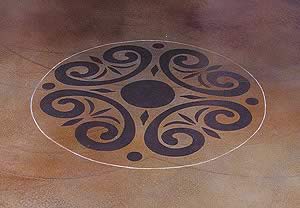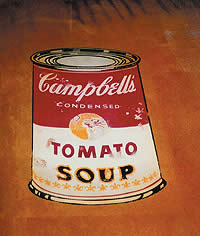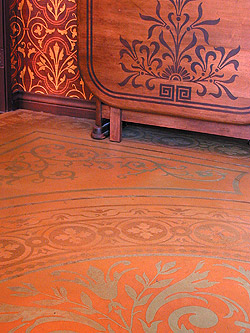
...continued from previous page
Floor Treatments
As decorative concrete continues to grow homeowners are seeking for contractors who can make their entryways, patios, driveways, interior floors and other concrete surfaces stand out.
by Stacey Enesey Klemenc
Doolan explains, through the combination of a vinyl adhesive design and a gelled acid that bites into an existing concrete surface. “It also allows for very detailed color placement,” through the use of the company’s gelled color thickener that eliminates colors wicking together and prevents color from spidering down under the design. The thickener, which is a gel that holds color, works well with both acid stains and water-base colorants.
 Prices for Flattoos range between $6 for stock and $8 for custom per square foot. There is no typical size and there are no size restrictions, Doolan says, but there is one limitation. “If we get a design that’s a square and you want us to make it into a rectangle, there will be distortion. We don’t recommend doing that,” she notes. “We ask the customer what is the most important dimension and size to that.” Prices for Flattoos range between $6 for stock and $8 for custom per square foot. There is no typical size and there are no size restrictions, Doolan says, but there is one limitation. “If we get a design that’s a square and you want us to make it into a rectangle, there will be distortion. We don’t recommend doing that,” she notes. “We ask the customer what is the most important dimension and size to that.”
Flattoos don’t require a highly skilled worker to get good results, the products have no VOC restrictions and they can be applied in small as well as large areas. All you need are need cheap paint brushes, plastic containers, a bucket of water and the Flattoo.
Overall, Doolan sums up, “It’s unbelievably easy,” not to mention a very fast way to create a special effect that will have clients coming back for more.
About a year ago, Melanie Royals, president and creative director of both Royal Design Studio and Modello Designs in San Diego, expanded her “Extraordinary Stenciled Effects” offerings with a new decorative tool she calls Modellos.
 Stencils come in certain sizes but every Modello can be custom-sized and cut to order,” she says, adding that Modellos can be cut out of a variety of materials of varying thicknesses depending on what surface they’re going to be used on and with what medium or decorative technique. Stencils come in certain sizes but every Modello can be custom-sized and cut to order,” she says, adding that Modellos can be cut out of a variety of materials of varying thicknesses depending on what surface they’re going to be used on and with what medium or decorative technique.
A Modello, which means “pattern” or “I model” in Italian, is a pre-cut pattern that’s printed on an adhesive-backed flexible material and, unlike your typical stencil, designed for one-time use. There are currently more than 800 stock patterns you can mix and match to come up with your own unique pattern. If you don’t find what you’re looking for, you can have the graphic artists on staff create a custom design specifically for your project.
“We can alter designs very easily. All our work is done on a computer so we can manipulate the design to fit the client’s particular needs,” Royals says. For instance, she adds, they can take a stock border and turn it into a circle or oval design of any size and diameter.
Modellos, which are usually more intricately designed than most stencils, typically run between $6 and $12 a square foot. “The price increases with both the complexity of the design and the thickness of the material,” Royals explains. She adds that her company has a price calculator on its Web site to help with estimates. “It’s a good quick way to get a ballpark idea of costs for different designs that you may be considering.”
Unlike Flattoos and sandblast stencils, Modellos can be used on wooden as well as concrete floors. They can also be used with sandblasting equipment when the thicker materials are chosen. Their flexible nature makes them a perfect choice for rounded surfaces such as columns and crown moldings. They also can be applied to ceilings and walls.
 In a situation where the design needs to fit around corners and elsewhere throughout the room, the designs can be adapted and modified. “You send us the exact dimensions of a room and we take the design you’ve picked and make it fit exactly. The Modello you receive flows seamlessly,” Royals says. There’s no picking up and repositioning or manipulating sections with this process, she says. “All the adjustments can be made by the graphic art department prior to cutting. All you have to do is install the pattern one time.” To save you additional time, she adds, the designs have all been “pre-weeded,” meaning there are no “hanging chads” for you to pluck and dispose of. In a situation where the design needs to fit around corners and elsewhere throughout the room, the designs can be adapted and modified. “You send us the exact dimensions of a room and we take the design you’ve picked and make it fit exactly. The Modello you receive flows seamlessly,” Royals says. There’s no picking up and repositioning or manipulating sections with this process, she says. “All the adjustments can be made by the graphic art department prior to cutting. All you have to do is install the pattern one time.” To save you additional time, she adds, the designs have all been “pre-weeded,” meaning there are no “hanging chads” for you to pluck and dispose of.
All you need to apply a Modello is a plastic burnishing tool and a pick knife to lift off the Modello when you’re done, both of which are included with every order. No unusual preparation is necessary prior to applying. The surface just needs to be clean, dried and cured so that the adhesive sticks properly.
“They’re very easy to apply,” Royals says, “and there’s a lot of educational support on the Web site that covers different methods and techniques you can use,” including gilding, paints, plaster and acid stains. She has a two-hour DVD/video available on how to install Modellos to create unique looks with a variety of different mediums, including wood staining. The San Diego studio also offers training sessions, and workshops are being formed around the country.
Currently, she’s working on developing a sprayable cementitious overlay to use with Modellos as an alternative to troweling on overlayments for embossed and inlaid pattern effects.
“As the industry becomes more sophisticated, people in the application field need to know how to offer a higher level of quality in design to keep up with the competition,” Royals says.
And learning the ins and out of all three of these decorative techniques is certainly a step in the right direction.

|

